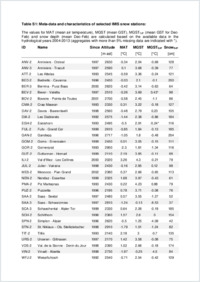Using near‐surface ground temperature data to derive snow insulation and melt indices for mountain permafrost applications
- Staub, Benno University of Fribourg, Department of Geosciences, Geography, Fribourg, Switzerland
- Delaloye, Reynald University of Fribourg, Department of Geosciences, Geography, Fribourg, Switzerland
-
01.01.2017
Published in:
- Permafrost and Periglacial Processes. - 2017, vol. 28, no. 1, p. 237–248
mountain permafrost
ground surface temperature
thermal insulation
snow onset
snow water equivalent
snow melt rate
English
The timing and duration of snow cover in areas of mountain permafrost affect the ground thermal regime by thermally insulating the ground from the atmosphere and modifying the radiation balance at the surface. Snow depth records, however, are sparse in high-mountain terrains. Here, we present data processing techniques to approximate the thermal insulation effect of snow cover. We propose some simple ‘snow thermal insulation indices’ using daily and weekly variations in ground surface temperatures (GSTs), as well as a ‘snow melt index’ that approximates the snow melt rate using a degree-day approach with air temperature during the zero curtain period. The indices consider point-specific characteristics and allow the reconstruction of past snow thermal conditions and snow melt rates using long GST time series. The application of these indices to GST monitoring data from the Swiss Alps revealed large spatial and temporal variability in the start and duration of the high-insulation period by snow and in the snow melt rate.
- Faculty
- Faculté des sciences et de médecine
- Department
- Département de Géosciences
- Language
-
- English
- Classification
- Hydrology
- License
- License undefined
- Identifiers
-
- RERO DOC 288639
- DOI 10.1002/ppp.1890
- Persistent URL
- https://folia.unifr.ch/unifr/documents/305427
Other files
Statistics
Document views: 193
File downloads:
- del_usn.pdf: 183
- Data_S1_R_functions.R.R: 62
- Table_S1.pdf: 94


